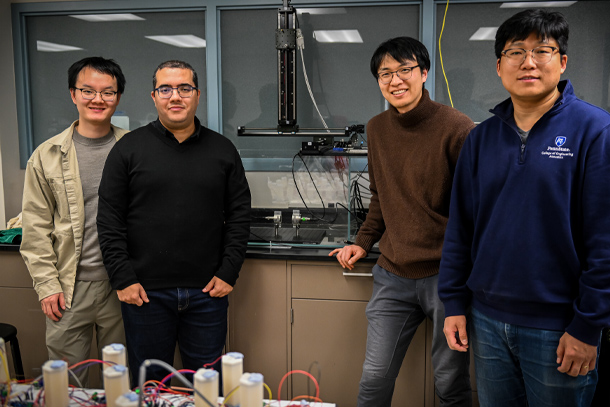
From left, Jiaxin Zhong, Mourad Oudich, Yun Jing and Hyeonu Heo, all from Penn State's Graduate Program in Acoustics, pose next to ultrasound lab equipment. They developed a way to convey energy and transmit communications through metal walls using ultrasound. Credit: Poornima Tomy/Penn State
Acoustic invention enhances ultrasound to access enclosed metal spaces
February 19, 2024
By Mariah R. Lucas
UNIVERSITY PARK, Pa. — The inside of underwater pipes and enclosed nuclear containers were inaccessible — until recently. Acoustics researchers in Penn State’s College of Engineering have developed a way to convey energy and transmit communications through metal walls using ultrasound.
They published their innovation, a pillar-based acoustic metamaterial that operates at ultrasound frequency range, in Physical Review Applied. The work could have implications for research in space, according to the researchers.
“If you wanted to power a device, such as a temperature sensor, inside a metal enclosure like a pipe, ultrasound waves can carry that energy to the device,” said Yun Jing, professor of acoustics and biomedical engineering and corresponding author on the paper. “But previously, the waves could not pass through metal barriers that would block sound, unless the transducers were in direct contact with the barrier.”
The researchers created a pillar-based metamaterial: an array of tiny, cylindrical pillars positioned on a metal plate that work as resonators, which vibrate or oscillate to create acoustic resonance.
When the metamaterial is situated between a transducer transmitter and a receiver, it dramatically enhances the ultrasonic power transmission rate through a metal barrier, without requiring direct contact between transducers and the barrier. Previously, faint ultrasound waves could pass through metal, but they lacked sufficient energy to power a sensor or pass messages through the metal.
“With a narrow end and a wider end like a pillar, the acoustic metamaterial is designed like an acoustic resonator,” said first author Jun Ji, who recently earned his doctorate in acoustics from Penn State. “The shape of the metamaterial allows for a wireless transmission and reception of ultrasound through a metal barrier.”
The researchers tested the function of the metamaterial sample in two experiments. In the first, they wirelessly transmitted power through a metal plate with the metamaterial using an ultrasonic transmitter and a receiver, successfully powering an LED light on the other side. This confirmed the metamaterial’s ability to transmit power through metal walls.
In a second test case, they transmitted an image of the letters “PSU” through a metal plate with the metamaterial using encoded ultrasonic signal, confirming that communications are possible with the use of the metamaterial strengthening the transmission of ultrasound waves through metal barriers.
Wireless communication and power for enclosed spaces can provide solutions for engineers in several areas, such as space exploration, Ji explained. Metal containers, for example, carrying samples from other planets would require a wireless alternative to maintain electrical power and communications.
“To avoid the potential contamination of samples being brought back to Earth, the container will need wireless sensors to identify and communicate pressure leaks,” Ji said.
Ultrasound communications — with the addition of the metamaterial — could be the solution to get samples back to Earth in the condition in which they were collected, Ji said.
In addition to Jing and Ji, the co-authors include Hyeonu Heo, Jiaxin Zhong and Mourad Oudich, all from Penn State’s Graduate Program in Acoustics.



